|
In the 19th century the population of Walsall rapidly
grew, as people moved into the area looking for employment
in the expanding industries. Within 40 years the population
had doubled, and doubled again in the next 25 years. By the
end of the century the population had increased almost nine
times to nearly 90,000, which would have been unimaginable
in 1800.
|
Population |
| 1801
|
10,399 |
|
1811 |
11,189 |
| 1821 |
11,914 |
| 1831 |
15,066 |
| 1841 |
20,852 |
| 1851 |
26,816 |
| 1861 |
39,692 |
| 1871 |
48,529 |
| 1881 |
58,802 |
| 1901 |
86,400 |
A New
Post Office
Around 1800 a new post
office opened on The Bridge. It had previously been in
the Bull’s Head Yard in Rushall Street, and is believed
to have been the town’s first post office. In the early
1800s the postmaster was Mr. Hill, who was assisted by
Mr. Bullock, the postman for the Borough who earned
seven shillings a week. When he delivered letters past
the pinfold he received an extra penny, and an extra two
pence for deliveries over a mile. Letters to the Foreign
were delivered by the postmistress, Mrs. Bullock. In
1813 the revenue for letters coming into the town was
estimated at £2,000 per year. The post was received at
11 o’clock, and the postal charges for letters were as
follows:
To London
- ten pence. To Lichfield - five pence. To
Birmingham - four pence.
In 1827 the post
office moved to Digbeth, with an entrance in Adam’s Row.
It remained there until around 1853 when it returned to
The Bridge, from where it moved to Park Street. In 1879
a new and much larger post office was built on the
corner of Leicester Street and Darwall Street.
Libraries
Walsall’s first public
library opened on 14th November, 1800 in Rushall Street.
It was founded by the Rev. Thomas Bowen, a Unitarian
minister, at his own house, and available to anyone on
the payment of a subscription. He provided a library
room, and a librarian. Bowen published several
educational books, and invented a number of mathematical
instruments. Around 1813 the library moved to a larger
room at Valentine and Throsby's stationery shop in High
Street.
|
| By 1830 there was a need for a larger
library. A public meeting was held on 16th August, 1830
which led to the building of St. Matthew’s Hall in Lichfield
Street which contained a reading room containing around
3,000 books, a news room, and a first floor gallery.
The stuccoed building, on the corner of Leicester Street
was built in 1830 and 1831 in brick and stone, to a Greek
Doric design, with a large portico supported by four
columns. It cost 1,600 guineas to build, raised by a sale of
shares costing £10 each. |

St. Matthew’s Hall. From an old
postcard. |
|
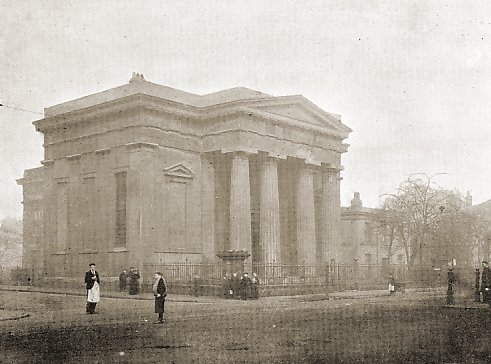
An earlier view of St. Matthew's Hall. |
Unfortunately the subscription proved to be too high,
and the library closed.
The building remained empty for
several years until it was purchased in 1847 by Mr. C. F. Darwall, Clerk to the Magistrates, for £620.
It was
initially used as a savings bank, until around 1855 when the
ground floor became the County Court, and a lecture room.
The first floor was used as a freemason’s hall, and also for
musical entertainment. |
|
The County Court
continued to be held there until the 1990s when it moved to
Upper Bridge Street. The building then became a bar, a
restaurant, a night club, and is now a Wetherspoons pub.
When the library and news room closed
in St. Matthew’s Hall, they were moved to John Russell
Robinson's printing works on the Bridge, where a literary
and philosophical institution was added, where lectures and
discussions were held.
In 1857 Walsall council decided to open
a library under the terms of the Free Libraries Act of 1850,
which gave local boroughs the power to establish free public
libraries. In 1859, a library building, designed by Nichols
& Morgan in a Renaissance style, was built in Goodall
Street. In 1872 the Free Library was converted to a news
room, and a library with a reading room above. Three years
later the books and papers from the library at Robinson’s
printing works were presented to the Free Library when the
subscription library closed.
In 1887 the Free Library was extended,
and in 1890 the upper room became the art gallery, museum,
and reference library. It was replaced in 1906 by a new Free
Library in Lichfield Street. The old free library building
still survives today as shops. |
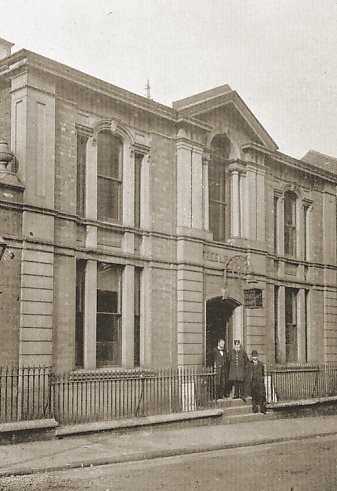
The Free Library. |

Walsall's second Free Library in Lichfield
Street. From an old postcard.
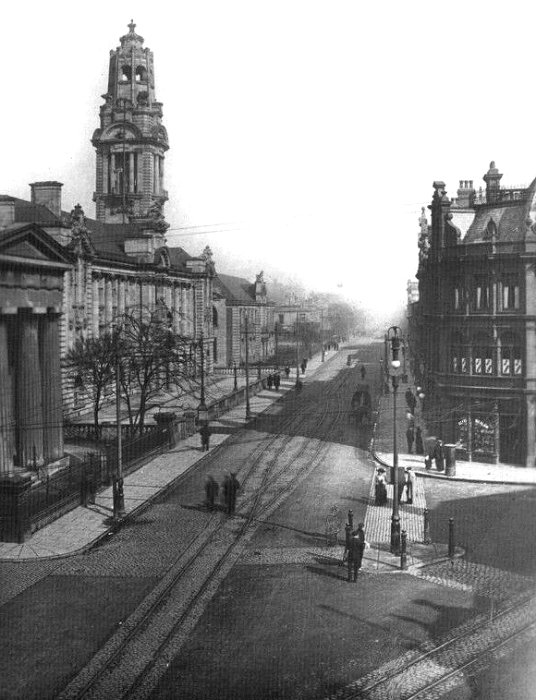
The new Town Hall.
|
Theatres
Until the early 19th century, most of
the entertainment in the town was provided by travelling
groups of players, in various halls and assembly rooms, the
most popular being at the Dragon Inn in High Street, which
had a stage, but no scenery.
|
| Walsall’s first purpose-built theatre
opened on the eastern side of the Old Square, just off
Digbeth, in 1803. It was built by
subscription, for which fifty pound shares were available. Each subscriber received interest on his investment, which
on paper looked good, because the takings for a full house
could average between fifty and sixty pounds.
Although
several well-known actors performed there, the venture was
not a success, and it closed in the early 1840s.
In 1845 the
proprietors were evicted for non-payment of rent, and a few
years later the building was converted into shops. |

Walsall’s first purpose-built
theatre after it was converted into shops. |
|
|
In 1839 Samwell’s Circus Royal was in
Goodall Street, and in the early 1840s Holloway’s Theatre
opened at Bloxwich racecourse. Productions included popular
plays and musical performances. The theatre moved to
Walsall, and was replaced at Bloxwich by Bennett’s Theatre.
Until the building of the Agricultural
Hall in 1868, entertainment was again mainly confined to
travelling companies and amateur groups, appearing in halls
and assembly rooms such as the Temperance Hall in Freer
Street, and the Guildhall Assembly Rooms in Goodall Street.
The Agricultural Hall was built on The Bridge opposite St.
Paul’s Church in what is now Darwall Street, and sponsored
by leading local farmers, millers, and grain dealers. It
could seat up to 1,000 people, and acquired a theatrical
licence in 1871 after which operatic and dramatic
performances were held. It opened as a permanent theatre on
26th March, 1883 and was run by Rebekah Deering who rented
the building. Unfortunately it was unprofitable, and
suffered the same fate as the Old Square Theatre. After
changing hands several times it was sold in 1885 to become a
public hall, known as St. George’s Hall. It reopened on 22nd
September, 1887 with an increased seating capacity of 1,500,
and was used for a time as a music hall. From around 1895 it
became known as St. George’s Theatre.
In the late 1890s it was rebuilt as the
Imperial Theatre by the Walsall Theatres Company whose
Secretary and Manager was William Henry Westwood who had a
great influence on the local theatres.. It
reopened on 22nd May, 1899 with a seating capacity of 1,600.
The new theatre only operated for around a year because the
company was already building Her Majesty’s Theatre at the
top of Park Street. The Imperial Theatre became Walsall's
first cinema in 1908, and screened its last film in 1968. In
1974 it became a bingo hall, and until recently a Wetherspoons pub.
It is Walsall’s last surviving theatre building from the 19th
century. |
|
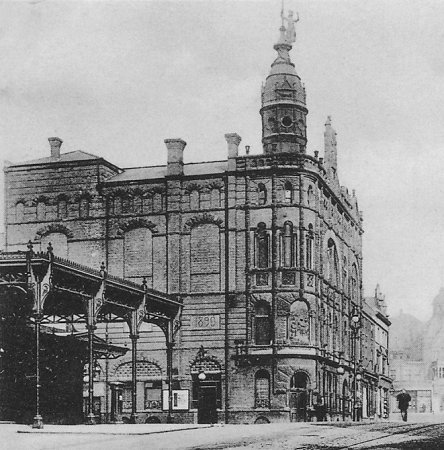
The Grand Theatre. From an old
postcard. |
Around 1870 Charles Crooke opened
Crooke’s Music Hall in his former beer and wine shop on the
corner of Park Street and Station Street. It became known as
the Alexander Theatre, until 1886 when it changed hands. The
new proprietor, William Henry Westwood changed its name to the
Gaiety Theatre.
In 1890 it was replaced by the ornate
Grand Theatre, built to the design of Daniel Arkell of
Birmingham.
It had a cupola on which stood a gilded
lady with a trumpet, and a niche containing another gilded
lady playing a lyre.
It cost £14,000 to build, and had a
seating capacity of 2,000, but like the other theatres was
financially unsuccessful, which led to its closure in 1899.
|
| Many famous acts appeared there including Vesta Tilley, the
gymnasts Volti and Ray, the comedian Frank Seeley, and the
Villion Troupe cycling act. A ticket for the gallery cost
six pence, but a ticket for the dress circle was priced at
two shillings, a lot of money for most people at the time. On 4th September, 1899 it was
officially reopened by Vesta Tilley as the Theatre of
Varieties, and became known for variety shows, silent films,
and drama. It became a cinema in 1931 after Associated
British Cinemas acquired the building. It remained in use
until 1st October, 1938, when it closed. After being
acquired by the grandson of the mayor, Pat Collins, it
reopened as the new Grand Theatre, but disaster struck on
6th June, 1939 when it was completely destroyed by fire.
Her Majesty’s Theatre Walsall’s most
successful theatre, Her Majesty’s Theatre, opened in 1900
and was built of brick and stone in French Renaissance
style, with a large copper dome on the roof and a tall
flagpole. The theatre stood at the top of Park Street on one
of the most prominent sites in the town, which had been
earmarked for the new Town Hall, until the council decided
to build it in Lichfield Street. It formed an impressive sight as seen from Park Street, and had a
lavishly decorated interior with fine ornamental
plasterwork, electric lighting, and a grand hall, paved with
a marble mosaic. The stage was 75 feet long and 45 feet deep
so that it could accommodate the most elaborate scenery and
the largest companies. It could seat over 2,000 people, and was known for its
high class dramas which were initially successful. |
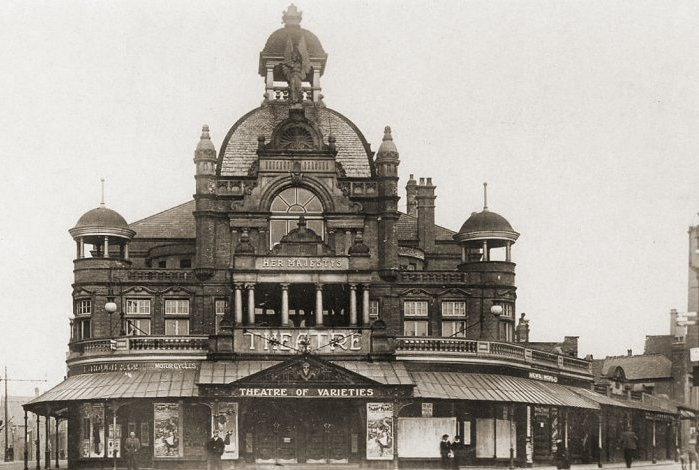
| It was
owned by the Walsall Theatres Company who engaged Owen &
Ward of Birmingham, a firm of specialist theatrical
architects to design the theatre, which was built by
Whittaker & Company of Dudley. The theatre was formally
opened on Saturday 24th March, 1900 by the Mayor of
Walsall, Councillor J. W. Pearman-Smith, and a large
number of guests. They saw a short musical, and enjoyed
a lavish tea. The theatre opened to the general public
on Monday 26th March with a musical comedy called 'The
Belle of New York' which was performed by the Ben Greet
Company. Tickets cost 6 pence and 9 pence for a seat in
the gallery, and one guinea for a ticket to a private
box. A varied programme of music, drama, and variety
became the norm. In 1903 the D'Oyly Carte Opera Company
performed 'The Mikado', 'H.M.S. Pinafore', and 'The
Yeoman of the Guard'. In 1906 Lily Langtry performed at
the theatre, and Harry Lauder topped the bill in 1908.
Sadly audiences started to decline, mainly due to
competition from theatres in Birmingham, and so Her
Majesty's turned to vaudeville, before becoming a cinema
in 1933. |
| In 1935 the building was acquired by Associated British
Cinemas (ABC), but the cinema was not a great success.
Audiences of the day did not appreciate the elegant
Victorian interior which was considered to be unfashionable.
The cinema closed on 5th June, 1937 and was demolished to
make way for the Savoy Cinema, later known as the A.B.C. In
the process, Walsall lost one of its most elegant buildings,
but no one seemed to care. There was no public outcry,
people were happy to see it go. |
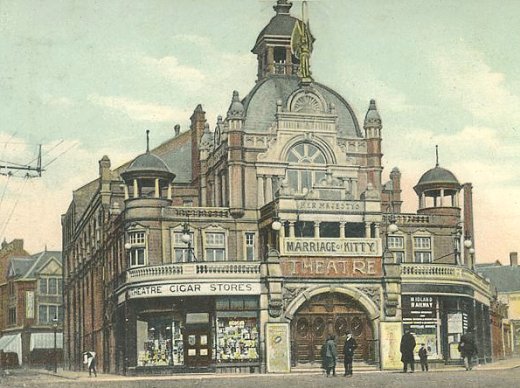
Her Majesty’s Theatre. From an old
postcard. |
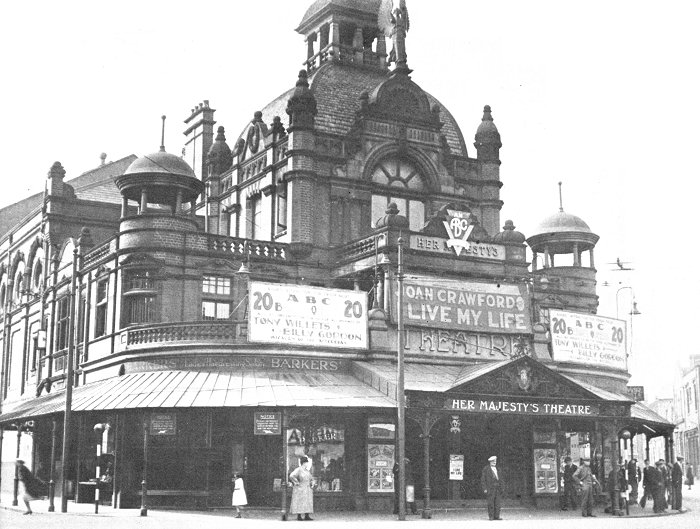
Her Majesty's Theatre in May 1936.
| |
|
View a couple of
early 1930s
programmes for productions
at Her Majesty's Theatre |
 |
| |
|
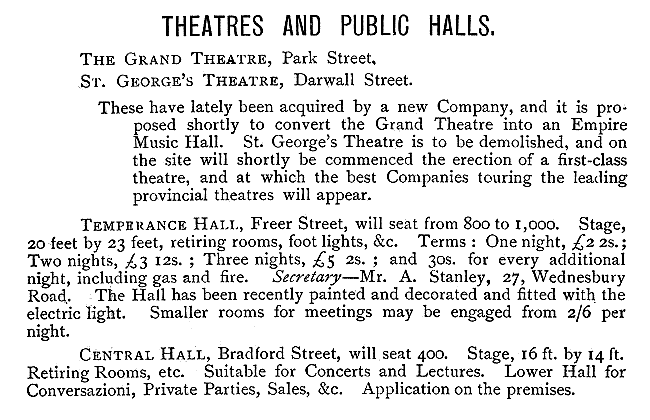
From the 1899 Walsall Red Book.
| The Temperance Hall and The
Empire |
|
In the mid 19th century
the temperance movement rapidly grew. In
1855 a temperance society was formed in
Walsall with the aim of reducing the poverty
and misery caused by the excessive
consumption of alcohol. The Temperance
Society purchased a piece of land in Freer
Street in1866, for the site of a temperance
hall, which would offer alternative forms of
entertainment to the public house, to make
people less dependent on alcoholic drinks.
The land was acquired
for £500 and a temperance hall was designed
by local architects, Loxton Brothers of
Wednesbury. The building, which took 9
months to build, cost £1,970, and was paid
for by public subscription. It was built in
the Italian style, of red brick, with
dressings of Bath stone and Portland cement.
The main entrance in Freer Street was via a
foyer with three pairs of swing doors.
The hall covered
an area of 65ft. by 45ft. and could
accommodate around 1,000 people on pine
seats on the floor and on a horseshoe shaped
gallery, which ran around three sides of the
hall. The hall ceiling was lavishly
decorated and well lit, with 5 gas
chandeliers, and side and front windows. At
the far end was the stage.
The building also
contained two reading rooms, two dressing
rooms, a lantern slide and film projection
room, a committee room, a dance hall on the
lower ground floor and cellars. Hall
keeper's residence rooms were also included
at the back.
The building, which
opened on the 2nd February 1867, was let for
religious, philanthropic and charitable uses
that were in keeping with the principles of
the Temperance Society. Each Christmas the
hall was opened for the ‘Robins' Breakfast’
for the poor children of the town, who each
received a packet of sweets, an orange, an
apple and were allowed to play games in the
hall. |
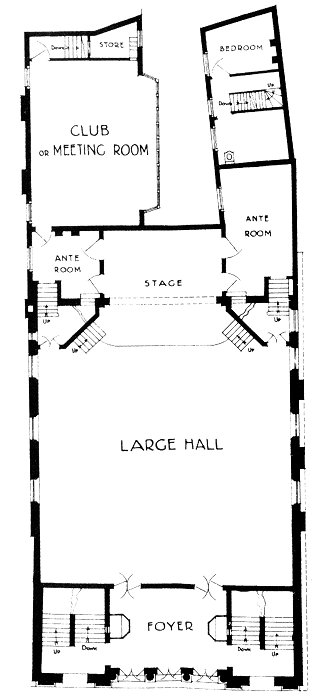
The ground floor plan
of the Temperance Hall. |
|

The Temperance Hall. |
On Saturday nights popular entertainment
was organised by musical or dramatic
societies. One of the first regular uses was
for a series of lectures organised by the
Walsall Literary Institute. The hall became
very popular and was in use most evenings.
In 1892 and 1893 the hall was used for
church services after the old St. Paul's
Church was demolished, until the new church
opened.
The hall was known for its excellent
acoustics and many celebrities performed
there including Oscar Wilde, who spoke on
'The House Beautiful' in 1884.
The first ever moving pictures seen in
Walsall were shown there by Mr. Shrapnel,
but the quality was very poor. |
| After the bombing of Wednesbury Road
Congregational Church, during the Zeppelin
raid on the 31st January, 1916, church
services were held in the hall until the
church had been repaired. |
| In June 1917 a Food Economy
Exhibition was held there, organised by
the Food Control Campaign Committee in
the hope of promoting new ideas to
housewives to help overcome the
shortages caused by the war. Things
went badly wrong on the 21st October,
1921, during a concert. A ceiling
support beam collapsed and part of the
ceiling fell onto the audience. One
person was killed and many were injured.
Expensive repairs were required and the
hall lost much of its former popularity.
The premises were
eventually put up for sale in May 1930
at the Grand Hotel in Birmingham and
sold for £13,500 to a Mr. T. Jackson,
from Bournemouth, who converted it into
a cinema. Before work began on the
cinema, a farewell meeting was held in
the hall during which Alderman Joseph
Leckie, referred to the days when the
Temperance Hall was at the height of its
success.
The new cinema,
called ‘The Empire’ was designed by J.
H. Hickton. The building work was
carried out by J & F Wootton of Bloxwich.
The original facade
was covered with white cement and new
entrance doors replaced the old swing
doors. A new floor was also installed,
together with upholstered seating for
1,200 people in the stalls and balcony.
The cinema opened on Monday 28th August,
1933 with a showing of the musical
comedy ‘Letting in the Sunshine’.
In 1937 The Empire
was sold for £20,000 to Captain Clift to
become part of the Clifton Circuit.
In 1954 it was
Walsall’s first town centre cinema to
install cinemascope, which was extremely
popular and resulted in long queues
forming in Freer Street, particularly
for each performance of 'The Robe'. The
last film to be shown there was
‘Cleopatra’ on the 24th October, 1964.
In February 1965
the cinema was demolished to make way
for the Old Square Shopping Centre. |

The Empire. |

The location of The Empire.
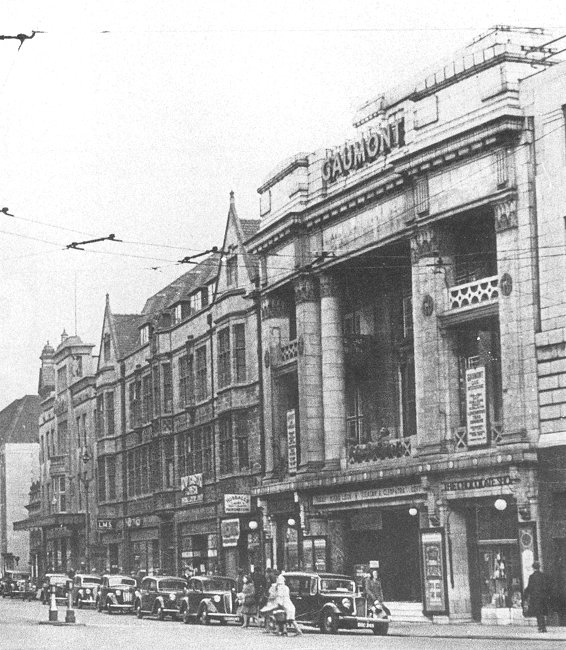
The Gaumont Cinema in
Bridge Street, where Coffee Republic and the
Co-op supermarket are today. |
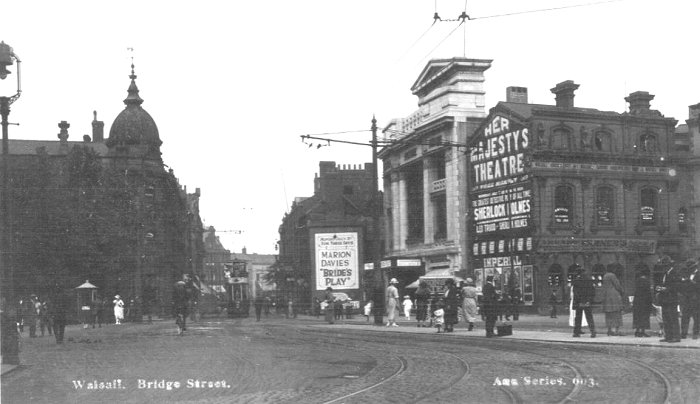
A 1922 view of Bridge Street and the
Gaumont. From an old postcard.

The Palace Cinema in the Old Square.

An advert from 1921.

A view of the Palace Cinema from 1949.
Shortages
F. W. Willmore includes an interesting
letter in his History of Walsall which gives an insight into
some of the problems faced by local people in the early
years of the century. It is from the December 1804 edition
of The Gentleman’s Magazine, and describes the inconvenience
caused by a shortage of small coins:
| Much inconvenience is felt in this
neighbourhood for want of silver in change.
There are many collieries, lime works,
forges, and furnaces which employ hundreds
of people, and the masters to pay their
workmen issue cards of various sorts, from
one shilling to ten each, nominal value.
These cards have been brought to the market
town adjacent, and paid for provisions,
clothing and other things, so that they
became a drug, and very little hard cash is
to be seen. Moreover, many of these have
been counterfeited, and the holders have
been obliged to sustain the loss. |
|
Water Supply
In 1804 large scale repairs to the
town’s water pipes were necessary in order to ensure that
the supply was clean and pure. In 1806 the network was
extended, and in 1810 and 1813 improvements were made to the
drainage system in High Street and Rushall Street. In 1814
the whole system was renovated at the cost of £90.
|
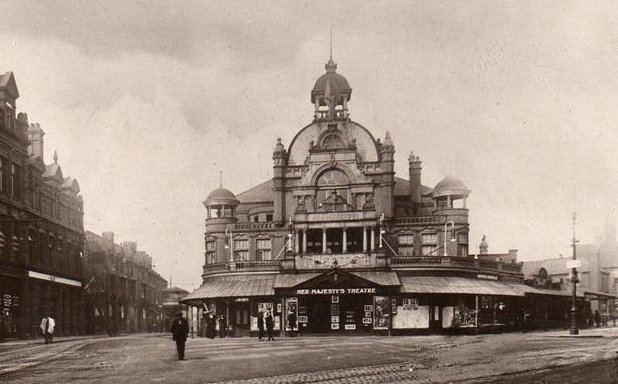
A final view of Her Majesty’s Theatre. From an
old postcard.
|
Law and Order
Policing in Walsall had never been
adequate, and so in 1811 after a spate of burglaries it was
decided to establish a public patrol for the protection of
common property. The parish was divided into six districts,
each with its own watch-house, which was funded from the
poor rate. Each burgess had to take a turn in keeping watch,
or find a substitute.
Each evening the people on watch would
assemble at the guildhall at 10.30 before going on duty.
They had the power to arrest and detain anyone acting
suspiciously, until the following morning, when they would
be escorted to the sheriff. If a prisoner escaped, a hue and
cry would be made in the area until he or she could be
recaptured. If a man on watch was killed in the execution of
his duty, his executors were entitled to a reward of £40. In October 1812 sixteen deputy
constables were appointed for the Borough, and eighteen for
the Foreign.
There had been a jail in Walsall since
the end of the 15th century, and a pillory, stocks and
whipping post beside the old market cross in High Street. In
the 17th century there was a town cage, and from 1627 a gaol
in the town hall. In the early 19th century it consisted of
two totally inadequate cold and damp rooms. Willmore
includes the following description in his History of
Walsall:
| Another insight into local life is
gained from some remarks on Walsall Gaol, by
a Mr. Nields to
Dr. Lettsom in 1802. He says, “Town Gaol, William Mason
gaoler, salary none, fees ¾ and 2d. to the
Town Clerk on commitment of every felon. Two
rooms under the Town Hall, that for debtors
has a fireplace, it is down five steps with
an iron grated window to the street, but not
being glazed and no inside shutters is
extremely cold, straw only upon the damp
brick floor to sleep upon. A door opens out
of this room into a dark dungeon for felons,
about three yards square. Adjoining to the
debtors room is one for felons, with an iron
grated window to the street, and two dark
dungeons with straw on the floor to sleep
on. Allowance to debtors and felons 2d. per
day. No court, no sewer, no water. The
beadle told me he brought it to the grating
for the prisoners. Felons for petty offences
remain here till the Quarter Sessions. The
debtors are confined here for less than 10s. |
|
Things improved somewhat in 1815 when
the gaol was rebuilt in the basement of the guildhall. It
then consisted of six damp cells around a small yard. There
were three fireplaces, but the walls were frequently so damp
that moisture trickled down them. The prisoner’s allowance
was limited to bread and water. At the same time a house was
built for the gaoler, who by 1833 received a proper salary.
Under the terms of the 1824 Improvement
Act, many improvements were made in the town, including the
provision of a night watch. In 1825 and 1826 watch men were
appointed, but the service was soon discontinued because of
inadequate funds.
|
|
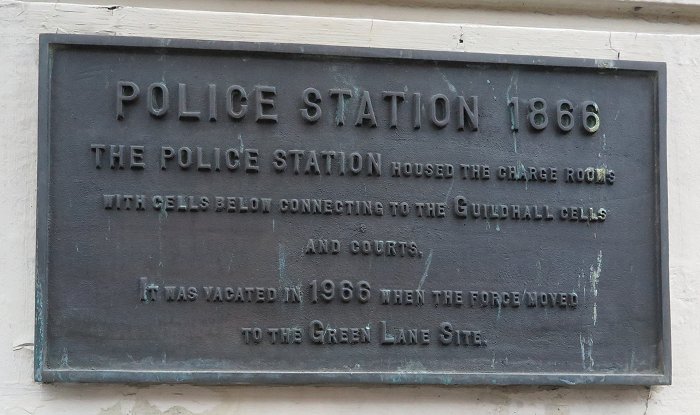
The plaque on the old police station in Goodall Street. |
|
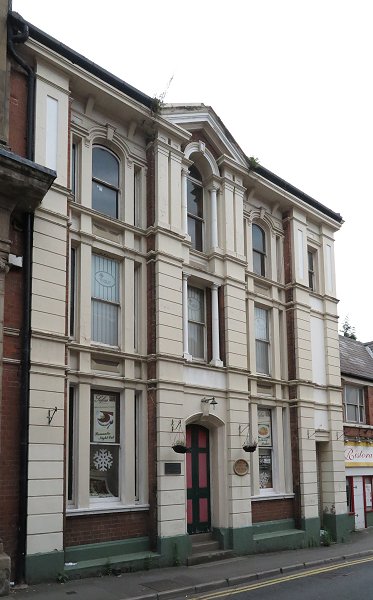
The old police station in Goodall Street. |
Things came to a head in the early
1830s. During the miners’ strike in 1831 six hundred special
constables were enrolled, and on election day in 1832 more
were enrolled, and troops were brought-in. At this time a
permanent police force was established, consisting of a
superintendent, and three officers.
They were based at a
police station that was next to the churchyard, and also
housed the fire engine. The building, known as the Station
House, was for the use of the police and the temporary
confinement of prisoners awaiting their appearance before
the magistrates. The cells were small, and the admission of
light and air was precluded by a mound of earth in the
churchyard, which surrounded the back of the building.
There
were no fireplaces in the cells, and the prisoners only had
straw to lie on. They had no blankets and were sometimes
kept there for eight days. Sometimes police officers would
allow them to use their front room where there was a fire.
In 1836 extra police officers were
appointed for Sunday duties, and in 1843 a new police
station was built in Goodall Street. From 1837, following an agreement with the County
Magistrates, prisoners from Walsall were housed in Stafford
Jail, and in 1843 Walsall Gaol was replaced by a lock-up in Goodall Street police station.
|
|
The Walsall police force came
into existence on the 6th July, 1832 after the Town
Clerk had written to the Commissioner of the
Metropolitan Police Force asking him to recommend a
man to form a police force in Walsall. The man
chosen was Mr. F. H. West who became Walsall's first
Police Superintendent. The following is from the
first report of the Commissioners on the Municipal
Corporations of England and Wales, March 1835:
|
The
Police consists of a
superintendent and three
permanent police officers,
appointed by the magistrates
during pleasure, and the two
sergeants-at-mace, in
addition to two constables
appointed at the court leet,
and 16 deputy constables for
the borough and 20 for the
foreign.
The
Superintendent and the three
police officers were first
appointed in July 1832. The
Superintendent receives a
salary of £70 a year, the
three officers, l7 shillings
a week each. The expense of
the establishment is
defrayed by a voluntary
subscription, to which the
corporation contribute
annually £50. In general all
warrants are executed by
these officers; before their
appointment they were
usually executed by the
sergeants-at-mace.
There
is no nightly watch. The
town is lighted and paved
under the direction of
commissioners appointed
under a local Act of George
IV. The commissioners are
authorised by the Act to
appoint nightly watchmen,
and in 1825 and 1826
watchmen were accordingly
appointed. They were however
shortly afterwards
discontinued, in consequence
of the rate which the
commissioners were empowered
to levy proving inadequate
to the purposes of the Act.
Upon
these watchmen being
discontinued, the
inhabitants of the principal
street in the town
contributed by subscription
to maintain a watch; but
this also was shortly after
abandoned, and the town has
not been watched by night
for several years. It was
stated that a nightly watch
was much required, though
the establishment of the new
police in some measure
lessens the evil which might
otherwise result from the
want of it.
Gaol
The
borough Gaol is situated
under the town hall, below
the level of the street. It
consists of six cells,
inclosing a small yard of
very insufficient
dimensions. This
establishment is altogether
of an unsatisfactory
character: no classification
beyond the separation of men
from women can be effected;
neither is it possible to
separate prisoners committed
for trial from those under
sentence after conviction.
There
is not sufficient space for
air or necessary exercise.
There are three fire places
in the gaol, but the cells
are frequently very damp; so
much so, that the moisture
trickles down the walls. The
prison allowance is limited
to bread and water. The
magistrates do not visit the
gaol regularly; sometimes an
interval of six months or
even more is suffered to
elapse without any
visitation being made. It
was stated by the gaoler,
that he had never known the
magistrate to visit the gaol
during the winter months.
The
mayor has the custody of the
gaol. He appoints a deputy
gaoler, usually one of the
sergeants-at-mace, who
receives as such, a salary
of £12.l0s. a year.
Station House
For the
use of the police and the
temporary confinement of
persons apprehended by them,
a station house has been
fitted up by the
corporation. It consists of
an entrance room for the use
of the officers, and two
cells for the confinement of
prisoners. This building is
also of a very inferior
description. The cells are
small, and the admission of
light and air to them is
precluded by a mound of
earth forming part of the
churchyard, which surrounds
the back of the building,
and rises nearly to the
height of the roof. The
walls are damp, and the
cells are without fire
places; the prisoners have
only straw to lie on, and
are not furnished with
blankets. Persons are seldom
confined here more than a
night, but it sometimes
happens that they are
detained longer: prisoners
have been kept here for
eight days, and in one
instance a female was
detained for a fortnight.
The officers usually allow
persons in custody to remain
in the front room, in which
they themselves sit, and in
which there is a fire; but
this is an indulgence
depending entirely on their
pleasure, and is not always
accorded. |
|
|
|
As already mentioned, the town’s fire
engine was housed in the police station next to the
churchyard. There had been a fire engine at Walsall since
the late 18th century.
It had been kept in the west porch of
St. Matthew’s Church, and also in an engine house near the lich gate, which had been built around 1790. The Improvement
Act of 1824 gave the town commissioners the authority to
provide a fire engine, which was kept in the engine house
next to the churchyard.
By the early 1840s there were two
new fire engines in the town, one in Lichfield Street
belonging to the Norwich Union Fire Office, and another in
Bridge Street belonging to the Birmingham Fire Office. When
they arrived, the parish fire engine was sold, and in the
early 1850s the old engine house was demolished.
|

Another view of the old police station in Goodall Street. |
| The Corporation fire brigade was formed
in 1879 and based at the police station in Goodall Street.
There were also sub-stations at Stafford Street police
station and Bloxwich police station. The brigade came under
the control of the chief constable in 1888. |

From the 1934 Walsall Red Book.

From the 1899 Walsall Red Book.
|
A new Grandstand
In 1809 a grandstand was added to
Walsall’s racecourse, which opened on Long Meadow in 1777.
The grand stand, which was supported by annual
subscriptions, was built at a cost of £1,300, and by 1823
had 34 subscribers, each of whom possessed a "subscribers'
ticket," entitling them to free admission.
It contained a
billiard room on the ground floor, and had a turret with a
bell. It survived until 1879 when it was sold for £72, and
removed from the site.
The races, which attracted large
numbers of visitors to the town, were supported by the
Corporation, which paid five pounds annually towards the
running of the course.
After each meeting a ball was held at
the George Hotel. In 1828 the Gold Cup was won by "Maria
Darlington," a chestnut mare belonging to Mr. Fletcher.
The
event was celebrated by Miss Foote, a popular actress, and
the Countess of Harrington who later that day sang "Little
Jockey" at the Walsall Theatre. |
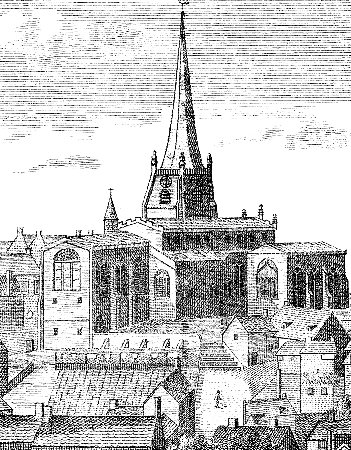
| Looking across the
town towards the parish church in 1795. From F.
W. Willmore's History of Walsall. |
|
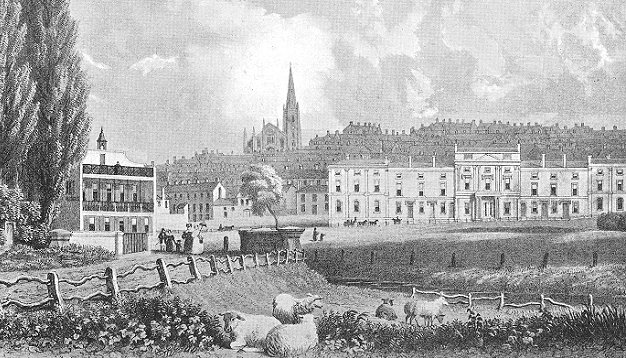
The old racecourse. From the 1899 Walsall Red
Book.
|
The Market
During the Napoleonic Wars the market
thrived, selling large quantities of Irish bacon to the
navy. Live pigs were shipped from Ireland for the purpose.
When the war ended in 1815 Walsall market continued to trade
in Irish pigs, and was one of the main English markets
dealing in them. Shopkeepers in High Street used to let pig
pens in front of their shops for the accommodation of the
pigs. In 1815 when a proper pig market was provided at the
back of High Street there was considerable opposition.
It has been claimed that in 1855 as
many as 2,000 pigs were brought to the market in a day. The
trade at Walsall soon suffered because of the coming of the
railways, and by 1889 few pigs were sold. During the latter
part of the century the market concentrated on general
retail sales, and grain. In 1835 barley, beans, oats, peas,
and wheat, were for sale.
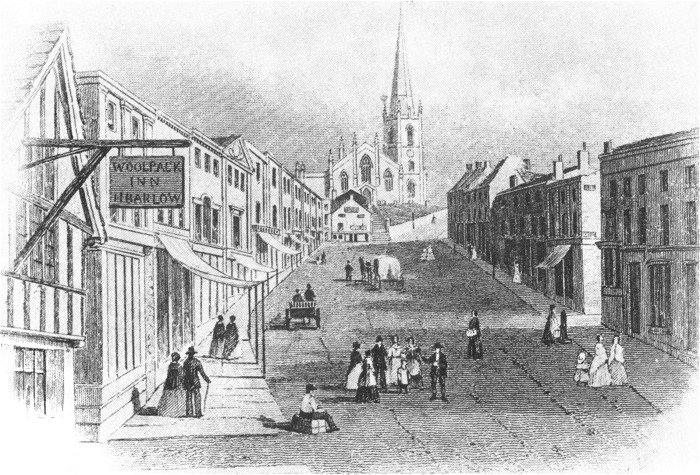
High Street in 1861. From an old
postcard.
The Gas Works
In the early 1820s there was great
dissatisfaction with the state of the town, particularly
with the lack of street lighting. On 28th May, 1824 the
Corporation obtained an improvement act for the town, at a
cost of £620. The 1824 Improvement Act gave the Corporation
powers to carry out improvements in the town centre,
including paving, lighting, and widening the roads. The
improvements were supervised by the improvement
commissioners, a body which included the mayor, capital
burgesses, the recorder, the town clerk, the vicar of St.
Matthew’s, the headmaster of the grammar school, the steward
of the manor of Walsall, the churchwardens, the overseers of
the poor, and 46 others.
The area for improvement covered the
Borough, Stafford Street, Wolverhampton Road, Marsh Lane,
Birmingham Street, part of King Street, and part of New
Street.
The commissioners had the power to make
and repair pavements, order residents to connect their
property to a sewer on pain of a £10 fine, light the streets
with gas and oil lamps, build a gas works, appoint and pay
watchmen, cleanse, name, and number the streets, ensure that
steam engines would consume their own smoke, on penalty of a
40 shillings per day fine to the owner, and provide a fire
engine, and weighing machine.
It was to be paid for by a rate not
exceeding three shillings, but in reality this was
insufficient. The improvements were subsidised by an
additional £900 from the Corporation.
In 1826 they opened a gas works on the
site of Arboretum Road. It was designed in 1825 by the
famous engineer John Urpeth Rastrick who formed Foster,
Rastrick and Company at Stourbridge with James Foster, and
built some early locomotives including the Stourbridge Lion.
The gas works were erected at a cost of £4,000, and let at
such a high rent that the Walsall rates were much lower than
in neighbouring towns. Unfortunately the gas works could not
keep up with the growing demand, and so in 1850 a new gas
works was built in Wolverhampton Street, alongside the
canal.
The work of the improvement
commissioners was taken over by the Corporation in 1876, and
in 1877 Pleck Gas Works was built by the canal.
Wolverhampton Street gas works then became a storage
facility.

The extensions to Walsall Gas Works.
From the 1937 Walsall Red Book.
Developments on The Bridge
At the start of the century the section
of Walsall Brook crossing The Bridge was fully exposed,
shallow, wide, and prone to flooding. It almost divided the
town in two, with Park Street and Digbeth sloping down to
the level of the stream. The houses on either side were
approached by flights of steps, so the whole area looked
very different to what we see today. The brook was crossed
by a low footbridge, which in times of flood could be
partially underwater. When this occurred ladies were carried
across on horseback for a fare of one penny. Horses were
kept for this purpose at the New Inn.
Around 1813 work began on improving the
area starting with the removal of the old manorial mill
which for some time had been used as a blacksmith’s shop by
a Mr. Chadwick. It was soon demolished and the materials
were sold for £31. In front of it was a watering place for
horses, and alongside stood a rubbish heap. Between the New
Inn at the bottom of Park Street and the brook, was a large
well known cock pit which was very popular during race
meetings.
Initially the mill race was partly
covered over, and remained as such until the enlarging of
the square to its present size in 1851. Other changes on The
Bridge included the enlarging of the Blue Coat School in
1826, and the enlarging of the George Hotel, also in 1826.
The pillars that adorned the front of the hotel were
purchased from the Marquis of Donegal in 1822. They formerly
stood in front of his stately home, Fisherwick Hall, which
was demolished. Before the work on the hotel began, the
front entrance was in Digbeth.
|

The Bridge and the enlarged George Hotel. From
an old postcard.
|
The Corn Laws, Politics,
and Rioting
The Corn Laws were introduced in 1815
to protect British farmers from cheap imported grain. No
foreign grain could be imported until domestic grain had
reached 80 shillings per quarter. It was seen as a way of
stabilising wheat prices, but in reality caused violent
fluctuations in food prices, and led to the hoarding of
grain. This only benefited landowners. At the time all MPs
had to be landowners.
It caused great hardship and distress
amongst the working classes, who could not grow their own
corn, and had to spend most of their earnings on over-priced
food in order to stay alive. There was much opposition to
the laws, which were not repealed until 1846. The following
extract from the edition of the Wolverhampton Chronicle
published on 6th November, 1815 describes some of the local
opposition to the inflated prices:
| The town of Walsall was thrown into
confusion on Tuesday night by a numerous
assembly of persons, by whom the windows of
several bakers were broken, and who
eventually attacked the new mill near that
place. They did not succeed in getting into
the mill, but they either destroyed or
carried away everything they could find in
the adjoining dwelling house. |
|
By 1820 Walsall was in the grip of a
severe depression, which caused much anger, and the signing
of the following petition:
| To Charles Windle, Esq., Mayor of the
Borough and Foreign of Walsall. Sir, we the
undersigned, do hereby request you to call a
meeting as soon as possible of the
merchants, factors, manufacturers, and other
inhabitants of the Borough and Foreign of
Walsall, to take into consideration the very
depressed and impoverished state of the said
parishes, and to draw up a petition to the
Commons House of Parliament thereupon, and
to adopt such measures as may be proper,
right, and legal. |
|
The petition, which had been signed by
a number of prominent citizens, led to a meeting at the
Guildhall, and the sending of a petition from Walsall to
Parliament which included details of the immense burden of
the poor rate, and implored Parliament not to accede to any
proposals for enhancing the price of agricultural produce.
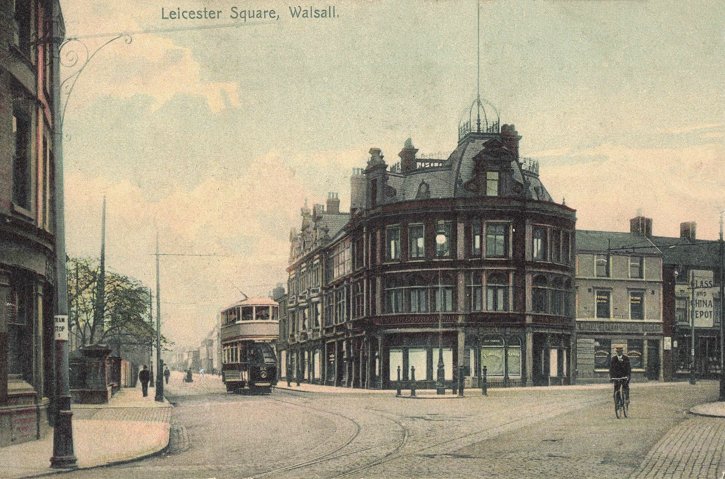
Leicester Square in the early 1900s.
From an old postcard.
Due to the high taxes, and high food
prices, the inhabitants of Walsall took an active part in
calling for the reform of parliament. Many joined the
Birmingham Political Union and held numerous meetings in the
town. In 1830 the Political Union for Walsall was formed at
a meeting in the Black Boy Inn in Fieldgate. Prominent
members included Samuel Cox, B. Abnett, J. Cotterell,
William Cotterell, and Joseph Hicken who was appointed
secretary. He later became secretary to the Anti-Corn Law
League founded in 1838.
In 1830 the anti-reform Tory Government
led by the Duke of Wellington were defeated, bringing Earl
Grey and the Whigs to power. A Reform Bill was introduced
March 1831, but it failed to get through Parliament and Grey
resigned, which led to a general election. It was fought on
the question of reform, and resulted in the re-election of
Grey and the Whigs with an increased majority. A second
Reform Bill was introduced, which went through the Commons,
and was awaiting its passage through the House of Lords.
Fearing that it would not be passed by the House of Lords,
the Birmingham Political Union held a meeting at Newhall
Hill, Birmingham to pressurise the Lords into accepting the
Bill. Around 15,000 people attended the meeting, but the
Bill was rejected, and large scale riots were held
throughout the country.
The Bill again passed through
Parliament with a large majority in March 1832, but it was
again feared that it would be rejected by the House of
Lords. By now the Political Union for Walsall had greatly
increased in size, and meetings were held at the Duke of
Wellington in Stafford Street, which was renamed the Earl
Grey. Because of the fear that the Bill would not be passed
by the House of Lords, around 200,000 people gathered at
Newhall Hill, Birmingham in what was known as the Meeting of
the Unions. Their aim was to pressurise the House of Lords
into accepting the Bill.
Around 500 members of the Walsall Union
met at five o’clock on the morning of May 17th at the back
of Mr. Hicken’s house in Windmill Street and with a brass
band playing, marched to Handsworth. They were met by
members of the Wolverhampton Union, and after a lively
discussion, Walsall took the lead into Birmingham. In spite
of the massive show of support for the Bill, it was defeated
in the Lords, and Grey resigned. The King called upon the
Duke of Wellington to form a new government, but he was
unable to do so, and Grey was recalled to office.
Feelings in Walsall were high, as can
be seen from the following article that appeared in the May
23rd edition of the Wolverhampton Chronicle:
| On Friday evening last, an effigy
intended to represent a noble duke, was
carried through the streets of Walsall. In
Stafford Street a man named Spencer,
probably to show his detestation of the
original, fired at the figure, as others had
done in its progress, but his pistol being
foul, instead of injuring the head of his
supposed enemy, rebounded against his own,
which was severely lacerated, etc. Mr.
Spencer is likely to carry with him for the
future a mark of his zeal in the cause of
reform. |
|
On 4th June the Bill finally passed
through the House of Lords and received its Royal assent
three days later. It was greatly welcomed and celebrated
throughout the country. Feelings were so high, that if the
Bill had not been passed, a revolution could easily have
followed.
As a result of the Reform Act of 1832
Walsall became a Parliamentary Borough. In December of that
year Charles Smith Forster, a Tory, a local banker and
former mayor was elected as Walsall’s first Member of the
reformed parliament., a seat he held until 1837. There was
much excitement in the town during the election, mainly as a
result of the political unions. Over ten thousand people
marched through High Street to the Dragon Inn where the
flags and banners were deposited. Many were members of the
Birmingham Political Council who supported Thomas Attwood,
one of the candidates, and one of their founders. A battle
followed between the Birmingham and Walsall men who were
armed with sticks and other weapons.
When Mr Attwood’s followers were
expelled from the George Hotel, the Birmingham mob broke
every window and forced entry into the hotel removing any
piece of furniture they could find, which was piled on The
Bridge, and set alight.
The Riot Act was read, and two
companies of the 33rd Foot charged the protestors with fixed
bayonets, until law and order was obtained. On the election
the following day, a company of the 33rd Regiment, and a
detachment of the Scots Greys was on hand in case of
trouble. An immense crowd formed on The Bridge, and a large
bonfire was lit. Attwood’s supporters tried to prevent
Forster’s supporters from reaching the polling booth. The
riot Act was again read, but the special constables that
were on duty could not control the angry crowd, and so the
Scots Greys charged through the mob on horseback, soon
putting them to flight. During the scuffle thirty five
arrests were made. It was a sad episode in Walsall’s
political life.
Other happenings in the 1820s and 30s
In May 1824 Walsall’s first savings
bank opened on The Bridge under the patronage of the Earl of
Bradford, the Earl of Dartmouth and others. Within a year
deposits amounted to over £7,000.
In the edition of the Wolverhampton
Chronicle for 23rd January, 1820 there is a mention of body
snatching in Walsall. At the time, the so called
‘Resurrectionists’ would open graves and remove, and sell
corpses for dissection or anatomy lectures in medical
schools. The news item is as follows:
|
Ressurrectionists
Several of these gentry have been
lately prowling about the neighbourhood of Lichfield, and
last week they stole the body of an elderly female from
Walsall Burial Ground.
|
|
In 1825 the Corporation finally decided
to discontinue the Mollesley Dole. In its place the
Corporation built eleven almshouses by St. Mathew’s burial
ground, for poor women, five from the Borough, five from the
Foreign, and one from Rushall. The decision was unpopular
and resulted in a considerable disturbance in the town.
Placards were put-up, and the authorities were subjected to
a great deal of scurrilous abuse.
The 2nd May, 1831 saw the opening of
Bradford Street, a new road to greatly improve the journey
between Walsall and Darlaston, and Wednesbury. People
assembled on the opening day to watch Mr. Quinton’s
Birmingham coach pass along the road, and stop half way for
the road naming ceremony.
The Coronation of William IV took place
on Tuesday 8th September, 1831. This was celebrated in
Walsall by a procession through the town which marched to
the grandstand at the racecourse. It consisted of the
mayor, John Heeley, the corporation, the odd fellows, the
druids, and other lodges. A few days later school children
paraded through the town to the racecourse where they were
given wine and cake. |
| In 1832 the town received an unwelcome visitor in the
form of Asiatic Cholera, which had been sweeping through
much of the country. In June it appeared at Tipton, and in
August caused a large number of deaths in Bilston.
It was suggested at the time that it arrived in Walsall
direct from Bilston, carried by the water in the canal,
mainly because the first victims lived alongside the canal.
|
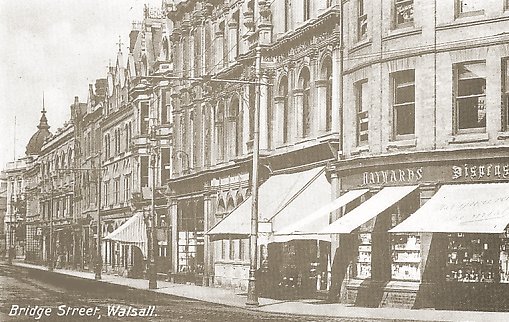
Bridge Street, originally called New
Street. From an old postcard. |
| The first man in Walsall to die from the disease lodged
in a house on the bank of the canal, and died within 24
hours. Another man who worked on one of the boats met with
the same fate. The whole neighbourhood around Walsall Town
Wharf was affected. People were dying rapidly, and no one
could be found to put them into coffins and carry them away
for burial. The local authority had to employ a man to go
around the neighbourhood twice daily, to remove the corpses.
One resident, Thomas Jackson, described the disease as a
shocking and agonising pain in the stomach and the bowels,
and cramp in the limbs, where life, even in the strongest
man, seldom held out for more than thirty hours. In that
year there were 346 cases of the disease in the town, and 85
deaths.
| |
|
Read a contemporary
description of
the cholera epidemic |
 |
| |
|
The Walsall Horticultural Society was
formed in 1834 thanks to the efforts of Dr. Kent and Mr. C.
F. Darwall. It prospered for three years, but soon came to
an end. The society reformed in 1880.
A New Council
When Lord Grey’s government had
succeeded in reforming parliament its attention turned to
local government. In February 1833 a select committee was
appointed to look into the state of Municipal Corporations
in England, Wales, and Ireland, and to report any abuses
that existed in them, and what corrective measures were
needed.
The commission issued its report in
1835 after investigating 285 towns, including Walsall. The
findings of the report led to passing of the Municipal
Corporations Act of 1835. The Act established a uniform
system of municipal boroughs, each governed by a town
council that was annually elected by ratepayers. The council
in turn were to elect aldermen to serve on it, with a six
year term. Towns were divided into wards. The Act reformed
178 Boroughs, and others soon followed.
The publication of the commission’s
report led to a crisis in Walsall. The Mayor, Charles
Forster Cotterell resigned, but was then informed by the
steward of the lord of the manor, that he could not resign.
This led to a special meeting of the Corporation who took
legal advice on how to proceed. A writ was issued by the
King’s Bench, ordering the Mayor to return to his office,
but he failed to do so.
A petition was sent to the House of
Commons from the inhabitants of Walsall in favour of reform,
and under the terms of the Municipal Corporations Act the
old Corporation was restructured into the new Borough
Council.
The first council elections were held
in December 1835, with only one member of the old
Corporation elected, he was Charles Forster Cotterell who
was re-elected as Mayor. The first council members were as
follows:
Foreign Ward: Charles Forster Cotterill,
Henry Wilkinson Wennington, Edwards Elijah Stanley, David
Badger, John Brewer, and Moore Hildick.
St. George’s Ward: Richard James
junior, Joseph Cowley, Samuel Powell, John Eglington, John
Wilkes, and Thomas Hackett.
Bridge Ward: Charles Forster Cotterill,
Joseph Cotterill, William Dixon, Samuel Smith, Thomas
Dutton, and Charles Mason.
The new council met for the first time
in January 1836.
|
 |
The Bridge.
From an old postcard. |
|
Walsall in 1835
In the early part of the century, the
old Corporation did little for the town directly, but was
active through the improvement commissioners, who did their
best to improve the town, according to the limited means at
their disposal. The principal improvements included the
construction of Lichfield Street, a fine new street
connecting Bridge Street to Lichfield Road. Other new
streets included Bradford Street, Goodall Street, Freer
Street, Mountrath Street, Great Newport Street, and Little
Newport Street. Many old buildings were removed or rebuilt,
and the growing, prosperous town began to look more
affluent.
| |
|
Read about the
Walsall Red
Books and the Walsall
Advertiser |
 |
| |
|
Although there had been many problems
with law and order, particularly due to people’s anger over
the Corn Laws and the Reform Bill, the same problems were
almost universal at the time.
The population was still growing, and
more manufacturing industries were appearing, which would
guarantee the future prosperity of the town. Walsall could
look forward to bright future.
|
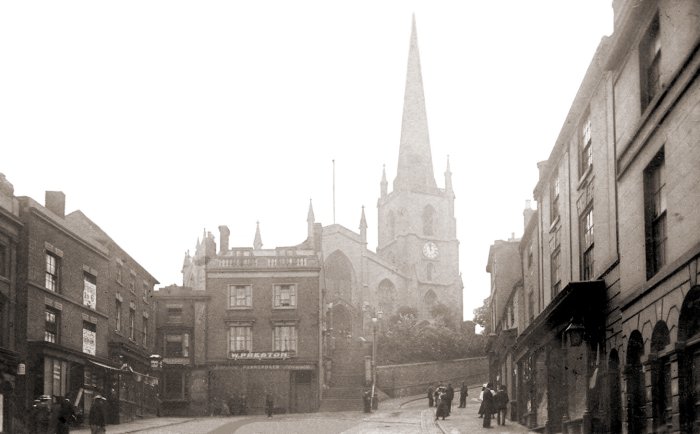
The view from the top of High
Street looking into Upper Rushall Street, around the end
of the 19th century. The shop by the church steps was
owned by William Preston, a pawnbroker. From an old
postcard. |
|
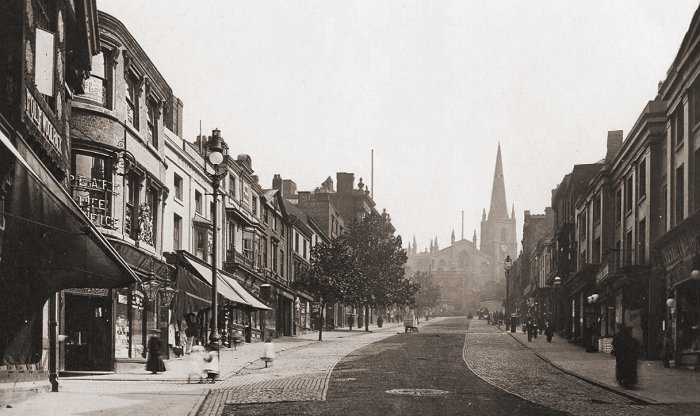
A similar view from lower down
High Street. From an old postcard. |
|

From an old postcard. |
|
 |
|
 |
|
 |
|
Return to Religion |
|
Return to
the beginning |
|
Proceed
to Industry |
|